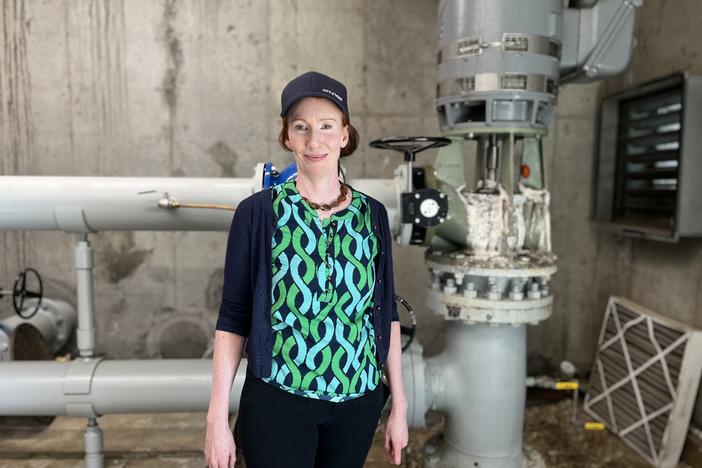Section Branding
Header Content
Huge waves are crashing on the California coast, in part due to climate change
Primary Content
California is getting more big waves, after a series of them thrashed the coast last week. High waves are increasing due to climate change, with impacts for coastal erosion.
Transcript
JUANA SUMMERS, HOST:
Giant waves are crashing along the California coast for the second time in two weeks thanks to stormy weather and high sea levels due in part to human-caused climate change. Tides are lower this week, so the waves are smaller, but they're still forecast to get as high as 20 feet through the weekend. That is thrilling for surfers, but, as member station KQED climate reporter Ezra David Romero explains, all these waves are also eroding the state's beaches.
EZRA DAVID ROMERO, BYLINE: When big waves happen, pro surfers drop everything and flock to them. On December 28, pro surfer Bianca Valenti caught the biggest wave of her life at Mavericks Beach, about an hour south of San Francisco. Forecasters had projected waves over 40 feet tall, but Valenti says this was bigger.
BIANCA VALENTI: It was about 60 feet tall and probably the same width.
ROMERO: She surfed part of the wave before falling, which was caught on video and posted on YouTube by the Mavericks Surf Awards.
(SOUNDBITE OF ARCHIVED RECORDING)
UNIDENTIFIED PERSON #1: Someone's up.
UNIDENTIFIED PERSON #2: Ooh.
UNIDENTIFIED PERSON #1: Just went down in a really bad spot.
ROMERO: As wave after wave pushed her deeper underwater, she told herself two things.
VALENTI: I said, I love this. I live for this. And I just relaxed. I think I probably got sent 50 or 60 feet deep.
ROMERO: A rescue crew eventually pulled her out of the water and jet-skied her to safety without injury. Even though surfers love these waves, the National Weather Service warned people to stay out of the water due to the danger. One Southern California lifeguard service performed 96 rescues over several days. Valenti again.
VALENTI: Tomorrow is not the day for somebody to go out for their first time.
ROMERO: Last week's giant waves resulted from a few things - high tides, a storm giving them extra speed from the Gulf of Alaska and higher seas due to climate change and the climate pattern El Nino.
GARY GRIGGS: Waves are getting bigger.
ROMERO: UC Santa Cruz oceanographer Gary Griggs has studied the California coastline for decades. He says that human-caused climate change will force seas to rise in the future, making waves even bigger. A Scripps Institution of Oceanography study from last summer found that California waves have grown, on average, a foot taller in the last 50 years as climate change has heated up the planet.
GRIGGS: All the indications are that the water is going to continue to warm. It's going to drive stronger winds, probably higher-intensity storms, greater wave power, bigger waves hitting more often.
(SOUNDBITE OF WAVES CRASHING)
ROMERO: All of this doesn't just create big waves for surfers. It can also erode beaches, destabilize cliffs and drown homes. Thomas Lundgard grew up watching surfers at Mavericks Beach. He helps run the Tommy Tsunami Surf School in Half Moon Bay. Lundgard said waves have already eaten up parts of beaches like Surfers Beach next to Highway 1.
TOMMY LUNDGARD: Surfers Beach has changed drastically where, you know, we used to teach a spot that was, like, further north. There's a staircase, and we used to be on the left side of the staircase. And then now that's just underwater.
(SOUNDBITE OF WAVES CRASHING)
ROMERO: At Mavericks Beach, USGS oceanographer Sean Vitousek inspects a pile of rocks that fell from the cliff onto the beach. He blames rain and waves.
SEAN VITOUSEK: Many of the beaches are currently in a pretty eroded state.
ROMERO: In a recent study, Vitousek found that, depending on the sea-level-rise scenario, California might lose about a quarter to three-quarters of its beaches. Erosion's a big deal if there's infrastructure nearby, he says, but not all erosion leads to catastrophic effects. Cliff erosion can replenish sand.
VITOUSEK: In some ways, these failures can be a good thing because they're a lot of sandy material that can eventually redistribute on the beach.
ROMERO: And while these waves are awe-inspiring, Vitousek says they're also a glimpse of our climate-changed future.
For NPR News, I'm Ezra David Romero in Half Moon Bay, Calif. Transcript provided by NPR, Copyright NPR.
Bottom Content



